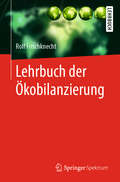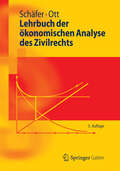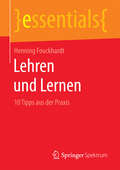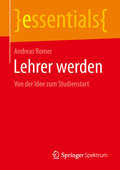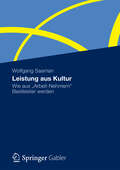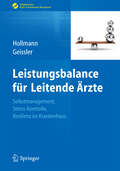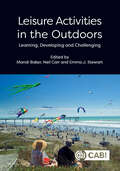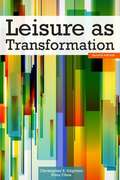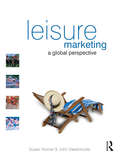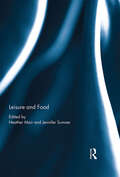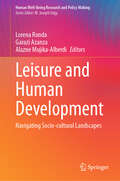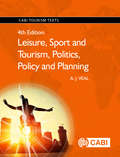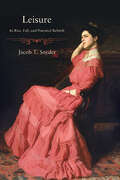- Table View
- List View
Lehman Brothers (C): Decline of the Equity Research Department
by Boris Groysberg Ashish NandaThis case tracks the rapid decline of Lehman Brothers' equity research department from August 1992, when, beset by declining ranking, low morale, and high turnover, firm management decides to clean house and reinvest in building the department.
Lehman Brothers (D): Reemergence of the Equity Research Department
by Boris Groysberg Ashish NandaSupplements the (A) case.
Lehman Brothers and Repo 105
by Gwen Yu Anette Mikes Dominique HamelThe collapse of Lehman Brothers in 2008 was the largest bankruptcy in US history. The case examines the economics of the off-balance sheet transactions Lehman undertook prior to the collapse, and highlights the corporate governance challenges in situations where firms face capital market pressure and market downturns. In particular, the case examines the financial accounting, auditing and internal management control practices around the Repo 105 transactions, which had a significant effect on the leverage position of the company. Based on the findings of the bankruptcy examiner's report, the case focuses on the role that management, external auditors, and the audit committee played in what amounted to a significant control failure.
Lehman Brothers and the Securitization of American Express Charge-Card Receivables
by Andre F. Perold Kuljot SinghIn early 1992, Lehman Brothers had received a mandate from its affiliate, American Express Travel Related Services (TRS) Co., to securitize a portion of its consumer charge-card receivables portfolio. It is now July 22, and Lehman and TRS have just returned from a "road show" that was undertaken to convince prospective investors of the merits of these new securities. Lehman must now price the securities. Because this is the first-ever securitization of charge-card receivables, there are no directly comparable benchmarks that can help in pricing. However, the securities share common features with credit-card receivables backed securities, which by now are well accepted. Another comparable is non-callable finance company debt. This deal is being watched closely by competing underwriters, investors, and senior management at TRS and Lehman. "Success" could catapult Lehman into becoming a major player in the asset-backed market whereas "failure" would be a major setback.
Lehrbuch Grundlagen der BIM-Arbeitsmethode: Fragen, Übungen, Fallbeispiele (erfolgreich studieren)
by Henriette Strotmann Habeb AstourEin allgemeingültiges BIM-Lehrbuch zu den Grundlagen der Arbeitsmethode BIM für Studierende und Lehrende an den deutschsprachigen Hochschulen. Jedes Kapitel schließt mit reflektierenden und zusammenfassenden Fragen und Übungen zu den vermittelten BIM-Kentnissen und -Fertigkeiten ab. Unabhängig von Institutionen und Software wird das Basiswissen neutral vermittelt. Videos zur Implementierung von BIM im Unternehmen runden das Lehbuch ab. Die Publikation erscheint in der Springer Vieweg Lehrbuchreihe erfolgreich studieren.
Lehrbuch der Ökobilanzierung
by Rolf FrischknechtIn diesem Buch werden die Grundzüge der Methode der Ökobilanzierung erläutert, aktuelle Bewertungsmethoden vorgestellt sowie praktische Hinweise für den Einstieg gegeben. Ein Exkurs in die Geschichte der Ökobilanzierung zeigt die lange Tradition des Lebenswegdenkens auf, welches seit dem 19. Jahrhundert praktiziert wird. Die Leserinnen und Leser bekommen die Methode der Ökobilanzierung anhand der Struktur der internationalen Normen ISO 14041 und 14044 aufgezeigt. Die seit jeher kontrovers diskutierten Themen wie Definition der funktionellen Einheit, Wahl eines passenden Systemmodells, Allokation und Recycling oder Modellierung eines Strommixes werden im Buch ausführlich behandelt. Dabei wird auf das unabdingbare Fällen von Werturteilen und den teilweise subjektiven Charakter von Entscheiden und Annahmen speziell hingewiesen. Auch die mathematischen Grundlagen der Ökobilanzierung erläutert der Autor Rolf Frischknecht systematisch.
Lehrbuch der ökonomischen Analyse des Zivilrechts
by Hans-Bernd Schäfer Claus OttDie Grundlagen der ökonomischen Analyse des Zivilrechts werden in diesem Buch anschaulich erörtert. Die Autoren des einzigen deutschen Lehrbuchs zu diesem Thema berücksichtigen dabei das Delikts-, Vertrags- und Sachenrecht, das Immaterialgüterrecht sowie das Insolvenzrecht und Grundzüge des Unternehmensrechts. Ein neuer Schwerpunkt der umfassend aktualisierten 5. Auflage ist der Einfluss der verhaltensökonomischen Forschung auf diese Analyse. Zudem werden die Europäisierung des Rechts und die internationale Konkurrenz von Rechtsnormen einbezogen.
Lehrbuch der ökonomischen Analyse des Zivilrechts
by Hans-Bernd Schäfer Claus OttDieses Buch enthält die Grundlagen der ökonomischen Analyse des Rechts und ihrer Anwendung auf das deutsche Zivilrecht. Es ist eine umfassende Darstellung dieser Forschungsrichtung, in der die Normen und Regelungsprobleme mit den Mitteln der ökonomischen Theorie analysiert und bewertet werden. Wichtige Argumentationsfiguren der ökonomischen Analyse des Rechts werden in die zivilrechtliche Dogmatik eingebaut. Bei der Analyse rechtlicher Regeln des Gesetzesrechts und des Richterrechts wird gezeigt, inwieweit diesen ökonomische Kriterien zugrunde liegen und inwieweit derartige Kriterien für die Rechtsanwendung und Rechtsfortbildung fruchtbar gemacht werden können. Die 6. überarbeitete Auflage präsentiert in fast allen Kapiteln neue Ergebnisse der rechtsökonomischen Forschung. Die psychologische Verhaltensforschung hat mittlerweile Eingang in die Diskussion vieler Facetten des Zivilrechts gefunden. Einige vieldiskutierte empirische Forschungsergebnisse wie zu den Wirkungen des kontinentaleuropäischen Rechts im Verhältnis zum Common Law müssen heute - insbesondere im Gesellschaftsrecht - in neuem Licht gesehen werden. Solche Entwicklungen werden aufgegriffen und es wird untersucht, ob und inwieweit diese Forschungsergebnisse für die ökonomische Analyse des Zivilrechts von Bedeutung sind.
Lehrbuch für digitales Fertigungsmanagement: Manufacturing Execution Systems - MES
by Jürgen Kletti Rainer DeisenrothDie Anforderungen an IT-Systeme im Produktionsumfeld sind permanent gewachsen und die Digitalisierung der Fertigungsprozesse ist ohne den Einsatz von Manufacturing Execution Systemen (MES) nicht mehr vorstellbar. MES dienen mittlerweile dazu, alle an der Fertigung direkt oder indirekt beteiligten Systeme, Elemente und Ressourcen im Sinne einer zentralen Datendrehscheibe sowohl horizontal als auch vertikal zu vernetzen. Sie sind damit eine wichtige Plattform für eine lückenlose Digitalisierung und den Aufbau einer Smart Factory.Wendet man die aufgabenorientierte Sichtweise nach der VDI-Richtlinie 5600 an, werden Manufacturing Execution Systemen wichtige Aufgaben aus den produktionsnahen Bereichen Auftragsmanagement, Feinplanung und Feinsteuerung, Betriebsmittelmanagement, Datenerfassung, Materialmanagement, Personalmanagement, Energiemanagement, Informationsmanagement, Qualitätsmanagement und Leistungsanalyse übertragen. MES helfen mit ihren Echtzeitbetrachtungen, vergangenheitsbezogenen Analysen sowie den Feinplanungsfunktionen dabei, die täglichen Herausforderungen im Sinne einer effektiven Steuerung und permanenten Verbesserung der Produktionsprozesse zu bewältigen.Dieses Lehrbuch erläutert im Wesentlichen die Funktionen und den Einsatz der Manufacturing Execution Systeme.Die Zielgruppen• Studierende der Fachrichtungen Wirtschaftsingenieurwesen, Betriebswirtschaftslehre und Wirtschaftsinformatik• Praktiker in produzierenden Unternehmen in fertigungsnahen Bereichen, im Controlling und im Management
Lehren und Lernen: 10 Tipps aus der Praxis (essentials)
by Henning FouckhardtHenning Fouckhardt gibt in diesem essential Lehrerfahrungen aus seiner mehr als 25-j#65533;hrigen Dozentent#65533;tigkeit in der Physik und den Ingenieurwissenschaften an Universit#65533;ten wieder. Er fasst diese in vielen Tipps f#65533;r das Gelingen motivierender Lehre und konzentrierten Lernens zusammen. Gute Lehre hat mit Detailarbeit zu tun, mit Motivierung, guten #65533;berleitungen, flexiblem Einsatz von Hilfsmitteln und Mut zum Fordern von Leistung. Gutes Lernen und Studieren beinhaltet viel Konzentration und #65533;bung, das Annehmen der Aufgabe, statt zu versuchen, sie zu umgehen. Nur Themengebiete, die man sich selbst erschlie#65533;t, kann man auch wirklich verstehen.
Lehrer werden: Von Der Idee Zum Studienstart (Essentials)
by Andreas RomerAndreas Romer informiert in diesem essential über Lehrerberuf und Lehramtsstudium und bietet so eine kompakte Orientierungshilfe für die Berufswahl. Basierend auf seinen Erfahrungen aus vielen Jahren in der Lehramtsberatung einer großen Universität werden häufige Fragen von Einsteigern und Spätberufenen thematisiert, beispielsweise: Welche Aufgaben haben Lehrer? Was macht gute Lehrer aus? Wie sind die Berufsaussichten? Wie finde ich einen passenden Studienplatz?
Leistung aus Kultur
by Wolfgang SaamanFühren bedeutet längst nicht mehr planen und Ziele zu setzen. Die Zukunft nimmt keine Rücksicht auf Planzahlen. Die Kunst besteht darin, sich als Führungskraft den Stärken der Mitarbeiter anzuvertrauen und Denkbeweglichkeit zu fordern. Wie die Unternehmensleitung diese individuelle Motivation der "Arbeit-Nehmer" selbst fördern kann, stellt dieses Buch anschaulich dar. Konkrete Handlungsempfehlungen und Tipps inspirieren und zeigen auf, was jeder Einzelne, ob Mitarbeiter, Führungskraft oder Unternehmensvorstand tun kann, um das Unternehmen im Gesamten wachsen zu lassen.
Leistungsbalance für Leitende Ärzte
by Angela Geissler Jens HollmannPerspektiven für Gestalter! Wenn wir davon ausgehen müssen, dass die wachsenden Anforderungen an Leitende Ärzte und die Arbeitsverdichtung erst den Beginn eines Zyklus markieren und keineswegs sein Ende, wird deutlich, dass es Werkzeuge und Techniken braucht, um die verantwortungsvolle Position auch in Zukunft erfolgreich gestalten zu können. Drei Aspekte sind besonders relevant. Standortbestimmung Klinik - Stressoren am Arbeitsplatz - Die Stanford-Formel Standortbestimmung Arzt - Der Präsentismus-Faktor - Die Gratifikationskrise - Typologien des Erfolgs Ressourcen zur Leistungsbalance - Zeit- und Selbstmanagement - Mentale Strategien für Stress-Resistenz - Denk- und Handlungsmuster erkennen und positiv transformieren - Techniken für eine wirksame Selbstregulation MIT - Checklisten - Selbst-Tests - Interviews: Chefärzte eröffnen Perspektiven für die Leistungsbalance "Dieses Buch hilft mit einem innovativen Ansatz ärztlichen Führungskräften, sich neue Perspektiven zu erschließen!" Dr. med. Jörg Ansorg, Hauptgeschäftsführer des Berufsverbandes Deutscher Chirurgen
Leistungskultur im Fokus der digitalen Transformation: Maschinen übernehmen keine Verantwortung (essentials)
by Wolfgang SaamanWie motiviert man Menschen zu Bestleistungen? Auf diese Frage gibt Wolfgang Saaman zahlreiche praxisnahe Antworten und macht die Notwendigkeit einer klaren Teilung von Funktion (Computer, Roboter) und Rolle (Mensch) deutlich. Menschen erbringen Spitzenleistungen auf Basis der Zufriedenheit mit der Rolle, dem Chef oder der Firma. Mitarbeiter kann man nicht wie Maschinen programmieren - man muss sie zu neuen Wegen inspirieren. Um auf die zuk#65533;nftigen Anforderungen des digitalen Wandels reagieren zu k#65533;nnen, m#65533;ssen Firmen in die F#65533;hrungsbeziehung zu Mitarbeitern investieren.
Leisure Activities in the Outdoors: Learning, Developing and Challenging
by Mandi Baker, Neil Carr, Emma J. StewartThe benefits of being outdoors in a leisure context are widely acknowledged across a range of disciplinary perspectives (including tourism, therapeutics, education and recreation). These benefits include the development of: health and wellbeing; social skills; leadership and facilitation skills; personal, emotional and reflective abilities; confidence and identity creation. Drawing on a variety of perspectives, geographies and approaches, this book explores the opportunities that leisure in the outdoors provides for learning, developing and challenging. The authors in this collection challenge dominant discourses of outdoor leisure through their selection of outdoor activities, theoretical approaches and modes of representation. All offer fresh insights and thinking into how leisure in the outdoors can be understood. The book covers a range of outdoor conceptualisations that challenge the reader to think deeply and broadly about the common threads which bind the broad field of outdoor leisure together. The experiences explored in this book range from suburban outdoors to wild places, surfing to mindful reflection, and trail walking to Nordic skiing, and encompass a broad spectrum of people. This book will appeal to outdoor scholars from a variety of contexts, including recreation, tourism, and adventure. It provides: ·original and leading research across layers of meaning attributed to and drawn from leisure experiences in the outdoors; ·value in theorising the notions of outdoor experiences; ·a variety and scope of contexts and approaches for students to draw on when learning about the field of outdoor leisure.
Leisure As Transformation
by Christopher R. Edginton Peter ChenHow does leisure promote, facilitate and enable change? Blending Eastern and Western perspectives, this book presents insight as to how leisure can be an optimal medium for change.
Leisure Marketing
by John Swarbrooke Susan HornerDivided into nine parts, Leisure Marketing: a global perspective guides the reader through leisure and marketing concepts, the marketing mix, key issues in different sectors, topical issues (such as globalisation, marketing research and ethics, for example branding and environmental issues), and the future of leisure marketing. A section of the book is devoted entirely to international case studies, which illustrate and highlight key themes and issues raised throughout in order to facilitate learning. Example of international cases used are: Disneyland Resort, Paris: The Marketing Mix Manchester United Football Club: Marketing the Brand The Growth of the Online Retail Travel Market Hilton Head Island, USA: The Leisure Island for Golf and Leisure Shopping Health, Leisure and Tourism Marketing including Spa Hotels, Health Clubs and lake Resorts. This book combines real world experience with a solid theoretical framework. It is essential reading for anyone studying, teaching or working in marketing in the leisure industry.
Leisure and Food
by Heather Mair Jennifer SumnerLeisure and food seem to be a natural fit, but the recent, unprecedented focus on all aspects of food has not been reflected in the field of leisure studies. This book is the first to combine these vital aspects of human interest by exploring the interface between leisure and food in a number of areas. For example, it examines sports nutrition products, which straddle the boundary between junk and food. It also looks into hosting sustainable meals, and what eaters can learn about sustainable food choices and food citizenship. It visits ethnic restaurants and inquires about the authenticity of eatertainment experiences from both the supply and demand side. And it takes up gardening, while investigating questions of food security, social capital, gardening narratives and the role of place. The book concludes with a dynamic reflection that sums up these leisure and food practices and sites, and challenges us to continue these debates.This book was published as a special issue of Leisure/Loisir.
Leisure and Human Development: Navigating Socio-cultural Landscapes (Human Well-Being Research and Policy Making)
by Lorena Ronda Garazi Azanza Alazne Mujika-AlberdiThis edited volume analyses emerging trends in the world of leisure and human development from the perspectives of subjective well-being and policy development. It brings together a diverse group of authors to delve deep into the transformative effects of leisure on human development and the future of sociocultural policy planning related to new directions in the field. Setting itself apart from existing literature, the volume offers a comprehensive view of the multifaceted nature of leisure and its significance in enhancing well-being and personal growth. It explores the emotional richness of leisure experiences, the impact on bridging generational gaps, and the cultural relevance of leisure within various sociocultural settings. This work uncovers the powerful role of leisure in shaping relationships, cultural institutions, and communities, revealing its profound influence on human lives. For those in the fields of practice, policy-making, or research, this book serves as a valuable resource for creating inclusive and meaningful leisure experiences. The volume is an indispensable addition to the literature on the subject, and is of interest to academics, practitioners, or laypersons interested in the dynamics of leisure.
Leisure, Sport and Tourism, Politics, Policy and Planning
by A. J. VealThis comprehensive, multi-disciplinary introduction to public policy and planning as carried out by governments and associated agencies covers the rights of the person as a citizen in terms of their needs and requirements for leisure, travel and sport, and the role of the state and market in meeting these needs. Expanded to include sport as a subject separate from leisure, this new edition of the successful Leisure and Tourism Policy and Planning also addresses the issues of climate change and global warming, which are crucial considerations for tourism planners and policymakers. It covers theoretical perspectives and practical guidelines for the application of a range of analytical techniques, and includes an extensive bibliography and questions and exercises for each chapter, making it an ideal text for students as well as practitioners.
Leisure, Sport and Tourism, Politics, Policy and Planning (CABI Tourism Texts)
by A.J. VealThe gap between theory and practice in the leisure, sport and tourism studies areas seems to have widened as scholars have become more specialized. Nevertheless, it is imperative that students be as familiar as possible with a wide range of social and political theory, and also be able to reconcile that knowledge with their own current and future roles as practicing professionals. A comprehensive, multidisciplinary approach to public policymaking and planning in the leisure, sport and tourism sectors, this book: - examines the theoretical issues underpinning public sector policymaking such as political ideologies, leisure wants, needs, demand and benefits, and human rights in leisure, sport, tourism and culture; - discusses the debates surrounding the role of the state versus market, and models of organizational decision-making; and - uses applied sections addressing strategic planning and performance evaluation to provide a link between theory and practical analytical techniques. As well as extensive updating of sources, this new edition examines such topics as libertarianism, theocracy, anti-establishment politics, and the concept of generations. A new chapter presents discussions of a number of 'issues and challenges' facing the leisure, sport and tourism sector. Introducing the subject for undergraduate and postgraduate students of leisure, sport and tourism, this book is also a useful addition to the shelf of any policy maker or practitioner within the industries.
Leisure, Sport and Tourism, Politics, Policy and Planning 4th Edition
by A. J. VealA comprehensive, multi-disciplinary approach to public policy making and planning in the leisure, sport, and tourism sectors, this book provides an introduction to the subject for undergraduate and postgraduate students. It examines the theoretical issues underpinning public sector policy making such as political ideologies, leisure wants, needs, demand, and benefits, and human rights in leisure, sport, tourism, and culture. Also discussing the debates surrounding the role of the state versus market and the models of organizational decision-making, it uses applied sections addressing strategic planning and performance evaluation to provide a link between theory and practical analytical techniques.
Leisure: Its Rise, Fall, and Potential Rebirth
by Jacob T. SnyderLeisure is a genealogy of the concept of leisure, from its peak in the classical age to its inversion and fall in modern liberalism. The goal of this genealogy is to analyze models of leisure and to inquire into the potential future shape of it. In that process, Jacob T. Snyder asks: what was leisure in its peak form in the classical age? In such a form, how was leisure understood to be connected to human flourishing? Then, what happened to leisure? What was the argument for work that won over the West? What must be rejected, or lost, about work if leisure is to be reanimated? In asking and answering these questions, Snyder argues that political reform, such as limiting work weeks, is insufficient to make us leisured. Leisure demands more, including a new understanding of what makes us happy and thriving creatures.
Leitax (A)
by Laura Winig Rogelio Oliva Noel WatsonLeitax, a young digital camera manufacturer selling its cameras mainly through retailers, experienced poor matching of inventory availability with demand for new and existing products in 2002. Describes the implementation and details of a consensus forecasting approach, a crucial part of a demand and supply planning redesign that was introduced to address the problem. The forecasting approach is a cross-functional one involving the sales, operations, and finance functions. Describes the results of the introduction, including planning challenges the company continued to face.
Leitfaden für Existenzgründer: Wie man sich als Ingenieur selbstständig macht (VDI-Buch)
by Erhard SanftDie Initialzündung einer Existenzgründung sollte durch eine in die Zeit passende Idee stattfinden. Das ist oft keine völlig Neue, sondern eine interessante Abwandlung bereits vorhandener Ideen. Der Gründer hat dann viel zu klären, wozu er hier die wichtigsten Hinweise findet: die geeignete Rechtsform, Pflichten gegenüber dem Finanzamt, betriebswirtschaftliche Fragen wie Preiskalkulation, Businessplan, Umsatzplanung. Letztlich muss eine solide Rentabilität nachgewiesen werden. Neben der eigentlichen Fachkompetenz müssen auch unternehmerische Fähigkeiten stimmen, die Marktbearbeitung und das Verkaufsmodell funktionieren; gerade dort liegen oft Gründe für Misserfolge. Im Buch werden die Einzelthemen und Beispiele für professionelle Vermarktung und der damit zusammenhängenden Verhandlungstechniken behandelt. Einfach verständliche Erläuterungen und Grafiken erleichtern das Verständnis und den Lernerfolg.


